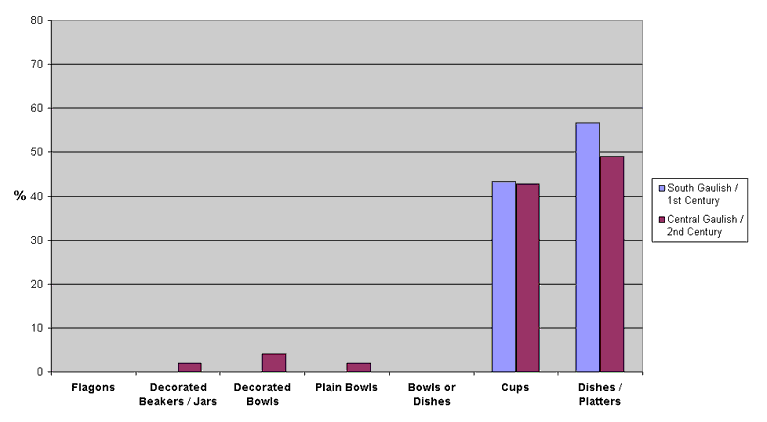Section 9.5 analyses samian vessels within graves, paying attention to the particular forms included in graves and on pyres and the condition of the vessels. It is apparent that some specific forms were preferred for incorporation within graves and that older, worn, damaged or repaired samian is disproportionately represented among the samian from graves.
Examination of the samian form types occurring in graves reveals a striking pattern: plain samian forms dominate the lists of samian vessels in graves, with decorated forms, notably the familiar decorated bowl forms, virtually absent. As noted in Section 7, decorated vessels (principally bowls) account for between approximately a third and a fifth of the samian types recovered from settlement deposits, and hence their rarity among grave assemblages must mean that they were not thought appropriate for inclusion with the remains of the dead. In contrast, samian platters, dishes and cups were intentionally selected for inclusion, consistently so over time and from site to site. This pattern is outlined in this section which draws upon the sample of cemetery environments listed in Appendix 9.1.
It was thought potentially useful to examine the occurrence of samian forms in graves by the type of site with which the graves are associated. As noted above, the data available in Appendix 9.1 relate to burials associated with three types of site/environs, namely major civil centres, smaller centres and rural sites/locations.
There are four samples available from cemetery environments relating to major civil settlements, specifically from the cemetery at St Pancras, Chichester, the Rosemary Lane car park Area II and Cranmer House, Canterbury, and the two burials from Winchester, Grange Road (cf. Appendix 9.1). In the case of the Grange Road burials, Martin Biddle (1967) suggested that they were located somewhat south of the core of Roman Winchester (Venta Belgarum) and so might relate to a separate settlement. They are included here with the 'major civil centres' category because of their proximity to this centre which may have influenced the availability of samian in this locality, and indeed since it is likely that Grange Road was a 'suburb' or satellite development of this centre. These two graves differ from many of those at Canterbury and Chichester considered here in so far as they were both furnished with a large number of pottery vessels and may be seen as representative of a particular regional tradition (cf. Millett 1987c); nonetheless there are levels of similarity in so far as the types of vessels present are consistent with the general pattern seen at Canterbury and Chichester.
The sample of sites therefore comes from Hampshire, West Sussex and Kent. Samian vessels were present in a total of 48 graves at these four cemeteries, with 82 samian vessels represented. The composition of this sample of 82 vessels is documented by source, form and generic/functional type in Table 61. As Table 61 demonstrates, these vessels come from a variety of sources and cover a range of 1st and 2nd century types. The main sources are La Graufesenque, with 30 vessels from this South Gaulish source, and Lezoux (36 items). Table 61 shows that the La Graufesenque vessels are all cups and dishes/platters. The specific cup forms well represented are Drag. 27 and Drag. 35, and the dishes/platters are mainly Drag. 18 and 36. The composition by generic form is very similar in the case of the Central Gaulish vessels from Les Martres and Lezoux, being likewise dominated by cups and dishes. Table 64 which summarises the composition of Table 61 by form type emphasises this domination by cups and dishes/platters. This is of special interest, of course, given that each vessel is the product of an intentional selection for inclusion in the grave at the time of burial. There is only one decorated beaker/jar among this sample of 82 vessels, and, strikingly, only two decorated bowls (both Drag. 37) despite the strong representation of decorated bowls among settlement deposits at major civil centres, as seen in Table 35. This is especially conspicuous when it is realised that among the hundreds of burials from the St Pancras cemetery, Chichester, there is not a single decorated samian bowl. Plain bowls are also absent; there is one present, seemingly a Drag. 31R, but even this vessel might be a 31 dish with rouletting rather than a genuine 31R bowl (Appendix 9.1, St Pancras, Burial Group 35; Down 1971, 93). Overall, it is particularly noteworthy that the pattern of selection of samian forms as grave goods was evidently consistent at these different sites over time. The preference for cups and dishes/platters is emphatic and contrasts with the composition of samian assemblages from normal settlement deposits.

Chart 18: Samian Form Types in Burials associated with Major Civil Centres: their Relative Frequency (Data from Table [Prov 36]; N = 79).
The trends in the composition of samian forms within graves at major civil centres are illustrated in Chart 18 above. This chart shows the relative frequency of the basic form types within this sample of graves. From the chart it is clear that the proportions of cups and dishes/platters going into graves remain similar over time, that is between the 1st and 2nd centuries. Dishes/platters were selected with slightly greater frequency than cups in both the 1st and 2nd centuries. Few other form types occur, and those present constitute only very minor proportions of the whole.
© Internet Archaeology
URL: http://intarch.ac.uk/journal/issue17/1/9.5.1_2.html
Last updated: Mon Mar 7 2005